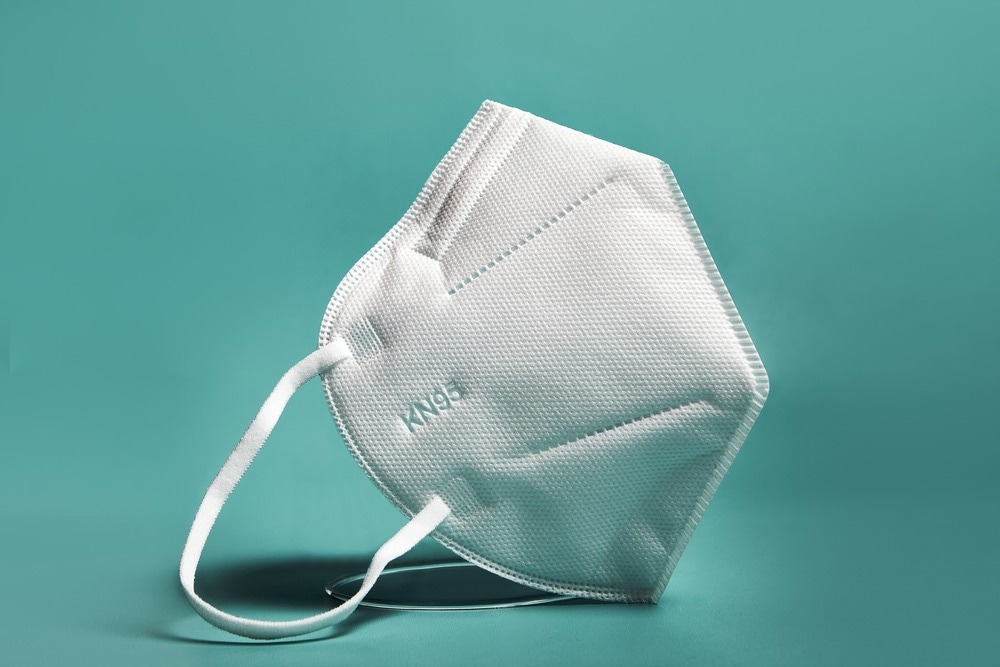In a recent study published in PNAS, researchers characterized the wettability of fibrous layers of N95 respirators or face masks using contact angle (CA) goniometers.
 Study: Multiscale landscaping of droplet wettability on fibrous layers of facial masks. Image Credit: danielmarin/Shutterstock
Study: Multiscale landscaping of droplet wettability on fibrous layers of facial masks. Image Credit: danielmarin/Shutterstock
Background
Fluid mobility is ubiquitous in nature, giving rise to droplets of varying sizes, and artificial surfaces that resemble fluid mobility have been designed in the past. Millimeter-size fluid droplets are frequently used to characterize wettability, even for face mask use, albeit droplet sizes targeted for such uses range between millimeters and micrometers.
Contrary to large-size droplets, micro-sized can sensitively interact with contacting fibers and are susceptible to being evaporated when used for face masks. Data for the size of droplets reported in previous studies skewed even after the global impact of coronavirus disease 2019 (COVID-19). Wetting characteristics at a single microfiber level have not been understood completely.
About the study
In the present study, researchers presented a multiscale landscape of mobility and wettability by following a testing regime excluded in previous studies and using one non-woven PP microfiber strand only to characterize wettability, extending the test regime to the characteristic ratio (D) value of 0.1.
The D value, obtained by selecting Dd (droplet diameter) and Df (feature size of underlying structures) as numerators and denominators, respectively, represented a skewed distribution (D>50) for previous studies’ data. The wettability of infectious virus droplets on fibrous layers of N95 masks was considered for D ranging from 0.1 to 100. It extended the regime to involve real infectious droplet distributions and the dynamic phenomena of wetting by them. Abrupt CA reductions were assessed in the regimen of D less than 10 because of the lowered air cushioning effect at the operating scale.
The team proposed an easy route of suppressing droplet wetting and adhesion by exploring the benefits of air cushioning in maintaining the extrinsic hydrophobic surface characteristics at an individual fiber level. The team carved nanowall structures into the pristine face mask fibers, which increased dewetting and hydrophobicity even when D values of 0.1 were considered. The outer fibrous layer of the commercial N95 mask was the region under investigation for the present study.
Four OF (observation frames) were set for the outer fibrous layer of the N95 face mask by altering the size scales with a 0.1 factor such that OF#1, 2, 3, and 4 were sized 5.0 × 5.0 mm2, 500.0 × 500.0 μm2, 50.0 × 50.0 μm2, and five by five × five μm2, respectively. The team measured the droplet CA values with all OFs, for the outer fibrous layer of pristine face N95 masks and the nanowall-structured layers through plasma etching, following which FE-SEM (field emission scanning electron microscopy) was performed for morphological assessments.
Subsequently, the team characterized the pristine outer layer at the multiscale level. Further, to avoid unstable experiment conditions because of swift evaporation, droplet wettability for the OFs was characterized and compared under high humidity conditions using an environmental SEM (E-SEM, >95% humidity). Nanoparticles were used as model viral particles for assessing the contamination area post-evaporation.
Additionally, the team carved pristine nanoscale fibers to dewet infectious droplets in 100>D>0.1 and compared fluid mobility for D ranging between 0.1 and 2.0. CA values were based on the droplet radius (r), and impact tests were performed by varying the droplet size and velocity. Laser scanning confocal microscopy (LSCM) analysis was performed to assess wetting behaviors.
Results
The multiscale landscape for pristine fibrous layers of N95 masks showed an abrupt droplet-wetting transition in the case of CA <90.0° when droplet sizes and microfiber diameters were similar during evaporation. The wetting transition could contaminate the fibers’ smooth surfaces considering D values between 0.1 and 1.
The team presented an approach for avoiding contamination of surfaces by increasing hydrophobicity, for achieving this, the simultaneous existence of amorphous and crystalline microfiber phases was explored by plasma etching, leading to nanowall structure embedment around every fiber. Air cushioning in fibrous media that were structured lowered the transition of wetting.
Additionally, air cushioning significantly lowered droplet adhesion, which is critical for lowering infectious virus droplet contamination of N95 respiratory surfaces. Dewetting behavior was observed with OF#1, whereas the small-sized droplets showed wetting in the remaining three OFs due to less air cushioning. Reduced CA values were largely observed in OF#3.
Further, the team observed dynamic droplet wettability on evaporation onto one fiber, where the pristine fiber droplet was suddenly pinned. Afterward, shear stress-induced contamination occurred in the contacting area for pristine fibrous layers. Pinning was observed with CA values of 75°.
Impact tests for fibrous face mask OFs #1 and #2 and one-fibre OFs #3 and #4 showed four possible scenarios after a droplet contacted the test surfaces, including deposition, break up with deposition, full rebounding, or break up with rebounding. Deposition and break-up with deposition were observed frequently among pristine fibrous layers, whereas break-up and rebounding were commonly observed for nanostructured fibers. Further, several droplets were piling up on pristine face mask layers, whereas every droplet was found to rebound against nanowall-structured layers consistently.
CA values for the pristine layer in OF#1 and OF#2 were 124°and 110°, respectively. CA values for the pristine face mask layer and the single microfiber strand were comparable. The droplet remained spherical irrespective of size, reducing the likelihood of virus immobilization since such contamination occurs by shear stresses post-evaporation-induced pinning.
Conclusion
Overall, the study findings showed a multiscale landscape of droplet wettability and mobility onto N95 masks and their structural derivatives in millimeter to micrometer droplet sizes.
The findings showed a reliable, practical, and scalable proof-of-concept approach using existing plasma etching methods to significantly improve fiber repellency with nanowall structures and reduce droplet adhesion probability with superior hydrophobicity, even at microscales. The approach would aid developers in ensuring that infectious virus particles are effectively eliminated from mask surfaces.